Today, while I was bottling for our members, I was contemplating how many different variables of milk production I could actually come up with. Who thinks about ‘all things milk’ besides me? Is all milk created equal? I realize it isn’t, but specifically, what affects the quality of the milk we pour into our cups at dinner time? The more I thought, the more I found that I could identify many different factors.
The most obvious two categories of milk I think everyone can agree on are:
- Processed (pasteurized)
- UnProcessed (raw)
But when we look more closely at those two categories, we can easily find more ways to identify different milk production variables beyond raw vs. pasteurized.
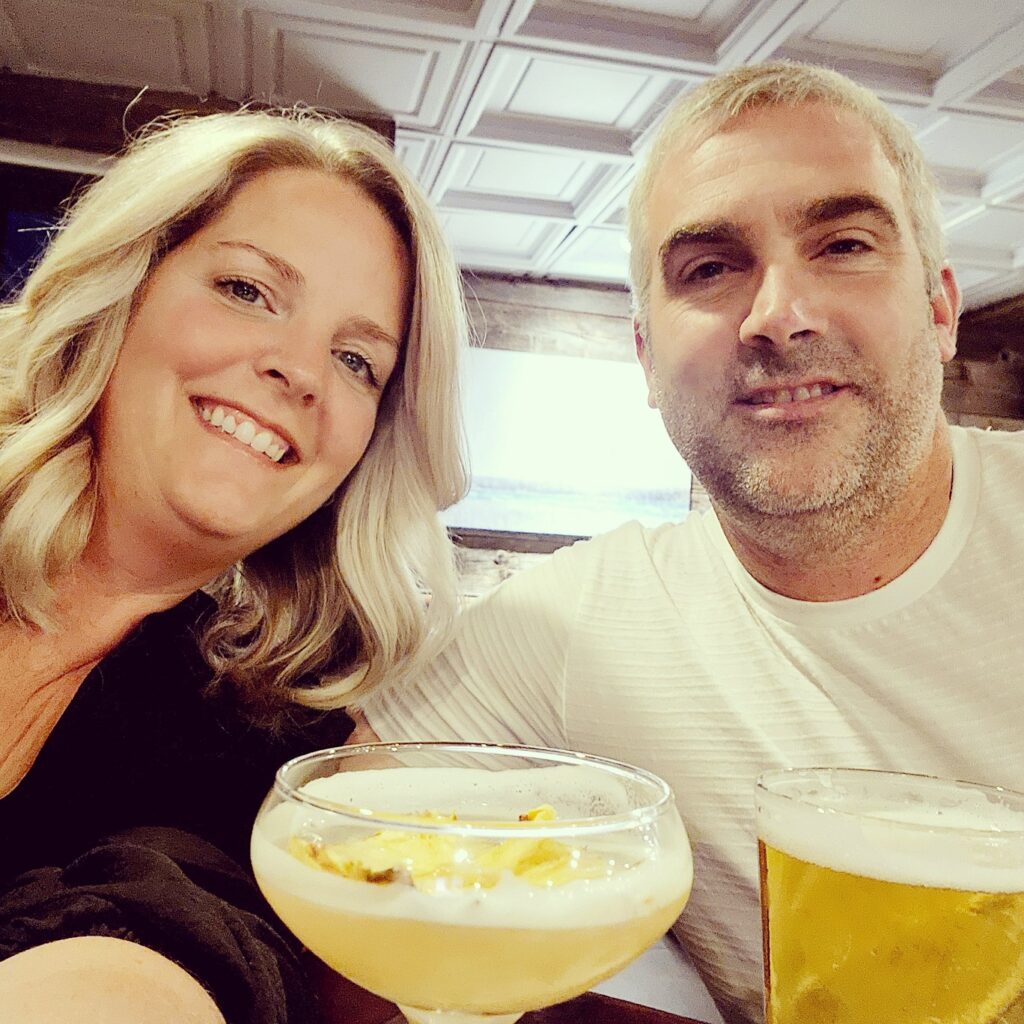
Before I go too far into this, I want you all to understand that my husband, Andy, is a fourth generation commercial dairy farmer. Their family farm, Jorasz Family Dairy, has shipped their milk to the plant for processing, along with thousands of other farmers, for over 100 years. Farms like theirs have fed the world for generations, and they are held to strict standards for animal welfare and milk quality. If you want to criticize the commercial dairy farmer, FIRST make sure you schedule a visit with one, talk to the farmer, and have them tell you all about the government regulations and inspections they get to deal with, just to get paid bargain basement prices for their product. They’ll also tell you about how uncared for, unhealthy cows do not produce, and they’ll show you all of the things that they do in the interest of animal health and welfare on their farms.
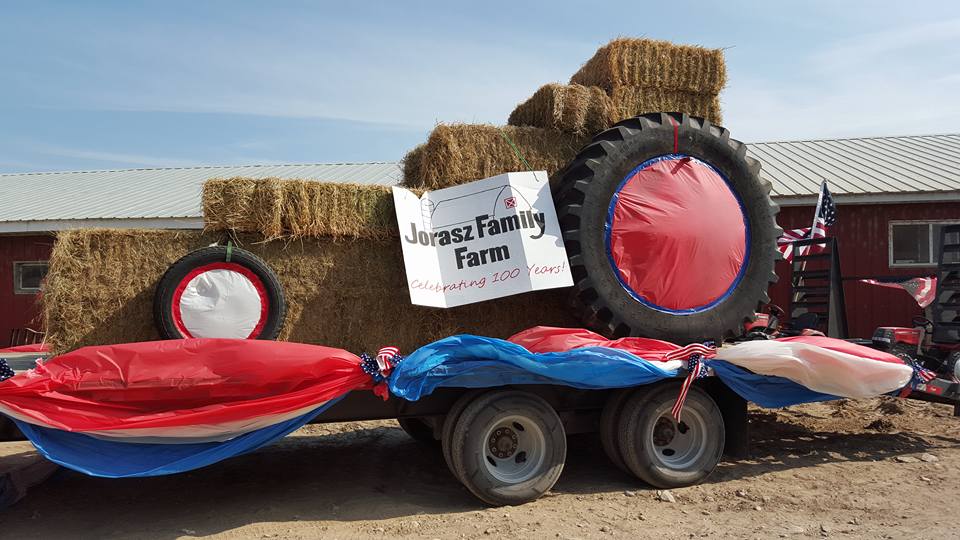
Pasteurized milk typically comes from commercial farms like Andy’s family’s farm. Most dairy cows on commercial farms are the typical black and white holsteins everyone is familiar with. Holsteins are bred to produce a ton milk very efficiently, eating a diet usually formulated by their herdsman or nutritionist. A specific mix of protein, carbohydrates, fat and roughage is designed to meet the needs of the herd. The cows typically live in confinement barns, otherwise known as free-stall barns. On the Jorasz Family Dairy, cows are provided soft mattresses in their stalls, that they are free to leave as they please, the floor is ‘swept’ of manure several times a day by an automatic barn cleaner that runs on a schedule. Water is provided automatically in troughs that are scrubbed weekly, and feed is provided for them to eat freely around the clock. The vet visits for herd health checks at least a couple times per month too! All of their needs are met, all they have to do is relax and make milk. Just like in all industries, even in farming, there are good actors and bad- but please don’t condemn the whole based on a few bad actors.
Commercial dairy cows typically produce A1A2 milk. This milk is piped through filters over to a bulk tank for cooling until the milk truck comes to the farm and picks it up. The milk truck driver takes samples from the farm’s tank before he pumps the milk over into his truck. The milk samples are very important, because at the plant they will test the milk in the tanker truck for antibiotics, and bacteria levels. If there are ANY antibiotics detected, the ENTIRE truck will be dumped to waste and they will test the samples until the culprit farm is found. Farmers are also paid more for lower bacteria milk, but the standard for bacteria in ‘milk for pasteurization’ is a lot different than what is acceptable in ‘raw milk for human consumption’.
Here is where we see the two general categories of raw milk, but these are just the beginning of the potential differences!
- Raw Milk Produced for Pasteurization– milk from commercial dairies that will be pasteurized at the Grade A dairy plant and processed into liquid milk, cheese, butter, and other dairy products. Standards for this milk are up to 100,000 bacteria/ml, and under 750 coliform/ml.
- Raw Milk Produced for Direct Human Consumption– Raw milk produced with the intention that it will be consumed raw directly by the share member, owner, or in states where raw milk is sold legally, purchased raw from the store or farm. Standards for this milk based on Raw Milk Institute best practices are up to 5,000 bacteria/ml and under 10 coliform/ml.
This post is already looking to be a lot longer than usual, and since I can’t say it better myself, here’s a handy little chart from the Raw Milk Institute that outlines the nutritional differences between raw and pasteurized milk, and other nut juices (I refuse to call them milk, but understand there are folks that need them):
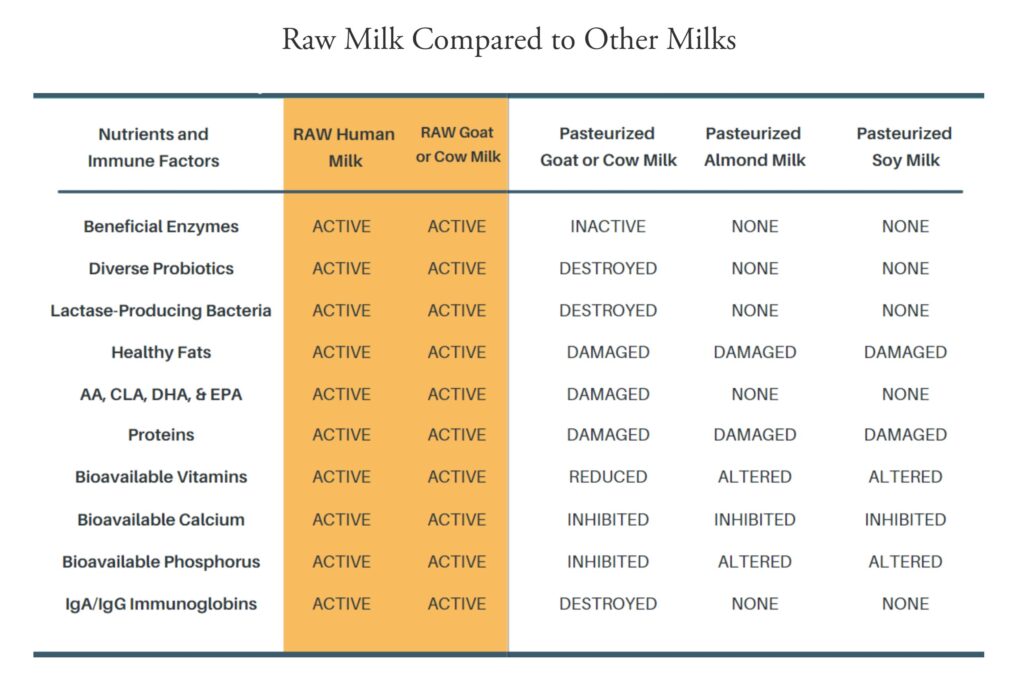
I don’t really want to concentrate on the differences between pasteurized and raw milk, we all get that I think. Rather, I want you to know that not all RAW milk is created equal.
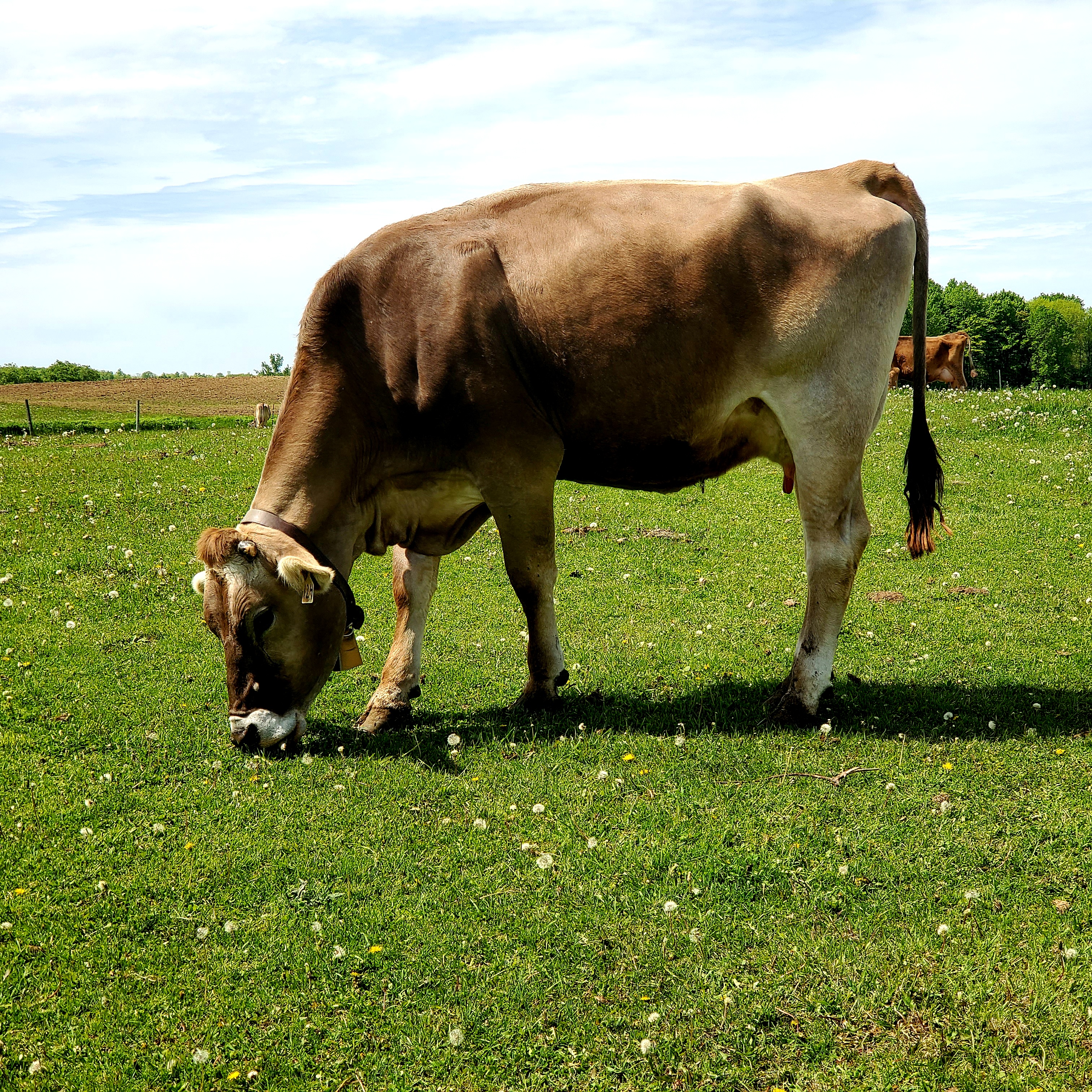
Here are some of the different raw milk considerations I thought of:
- Raw milk produced for pasteurization- I think we covered that well.
- Pasture Raised Raw Milk– from pasture raised cows that likely receive a ration of grains during milking. Like our Brown Swiss cows who are not 100% grass-fed genetics, they need a little more than pasture and hay to maintain body condition and supply. They still eat mostly grass, and live out on pasture.
- 100% Grass-fed Raw Milk– from cows that are bred to do well on only grass for feed. They are not given any grain supplementation and live out on pasture.
- A2A2 Raw Milk– from cows that do not produce milk with the A1 protein. Many people who have issues with milk have sensitivity to the A1 protein found in most commercial milk, so A2A2 milk is a great option. A2A2 milk is more common in heritage breeds like Jersey and Brown Swiss among others.
- Hand-Milked Raw Milk– I think this makes sense for someone milking their own cow or for a small herd share. It’s more difficult to keep milk from getting contaminated, but someone that is very conscientious can definitely produce low risk raw milk this way.
- Machine-Milked Raw Milk– With a pipeline barn, its a smidge harder to keep bacteria low, but without the pipeline, like we do, is an ideal situation for a larger herdshare that milk several to many cows. Milk is carried in closed milkers to the milkhouse where it is filtered into the bulk tank for cooling. The only reason the pipeline is a little more challenging in regards to bacteria is that its just more parts and surface area to keep clean, that’s it, but it can be, and is done all the time.

The last consideration I want everyone thinking about when they are seeking out raw milk is the integrity and education of the farmer. The milk can be A2A2 from 100% grass-fed cows, but if the farmer doesn’t know about producing clean, safe raw milk, you might as well buy what’s in the store. If you consume contaminated milk, it doesn’t matter if it’s got bio-available nutrients- they aren’t going to stay inside you long enough to absorb.
When you visit the farm, ask them-
- What is your udder care routine? Udders should be thoroughly clean and dry before milking and a sanitizing pre-dip should be used on each teat. Milk should be stripped from each teat and examined or tested for signs of mastitis. After milking, teats should be dipped with a protective post-dip to help avoid teat contamination in the pasture.
- What is your process with milk from fresh cows? (cows who recently had a calf) Our process is to test a fresh cow’s milk after she has been in milk for at least two weeks, and only add it back to the tank if the bacteria and coliform counts are within our guidelines from RAWMI.
- Do you calf-share? Allowing calves to stay with their mothers is common practice, but risky. If they do calf-share, make sure the udder care routine is spot on. We do not calf-share due to the risk calves pose in contaminating clean raw milk, but they are fed their own mother’s milk from a bottle.
- Are your cows ever treated with medications, and if so, what is your process? All milk from treated cows should be dumped for the recommended withdraw period for whatever medication is given.
- Do other livestock live with your cows? If so, make sure udder care routine spot-on.
- What is your process for milking- machine or by hand? If by machine great, if by hand, ask how they keep contaminants out of their bucket, how its filtered, and how quickly the milk gets cooled.
- How do you clean your milking equipment? They should have a process in place to rinse, wash and sanitize their equipment, depending on type, after each milking and possibly before the next.
- How quickly is milk cooled and to what temperature? 20 minutes or less is ideal, and they should be able to tell you because they should be measuring it.
- How often do you test your milk and what for? Testing should be done regularly and for bacteria and coliforms at a minimum. See standards that are noted above. We have an on-farm lab that was sponsored through the Raw Milk Institute so we test several times per month!
- What is your bottling process? Bottling should be done by trained farm staff using sanitary techniques for caring for milk jars and bottling equipment. If you belong to a share that allows members to bottle milk themselves, run, don’t walk, away. Just think of all the hands that have possibly touched your milk before you through handling the bottling equipment. Every time milk is bottled, the equipment needs to be disassembled and sanitized.
This post goes into detail on our testing and protocols: Protocols and QC
And if you’re not near our farm, navigate to the Raw Milk Institute site to learn about farms in your area that have been taught how to produce low-risk raw milk. Follow along with RAWMI because new farms are being certified all the time!
As you all look at what’s available to you in the grocery store and on the farm (through herd share or from your own farm in Michigan), I hope you find this information helpful. Yes, raw milk costs more to produce per gallon than what is in the store, but once you understand what goes into producing it safely, and the nutritional advantages, I think you’ll see that raw milk from a RAWMI LISTED farmer is the way to go!
Help educate others by sharing this information!
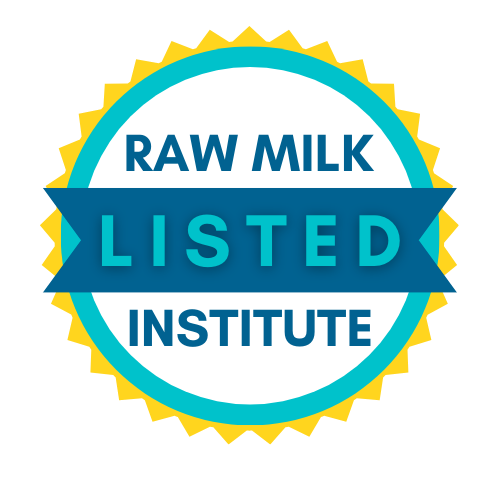
SUPPORT RAWMI
Join the Raw Milk Institute in their mission to provide universally accessible, clean, safe raw milk! As a 501(c)(3) non-profit organization, RAWMI depends on donations from people like you to be able to continue their work! Click ‘Donate Today’
Donations to RAWMI allow us to make vital information available to all, and help us move the industry forward. Donate today and help make a difference!
Connect with us on Facebook and Instagram to contribute to the conversation!
Spread the Word: Tell your friends, your family – and your farmer – about RAWMI!
Raw Milk Institute Website

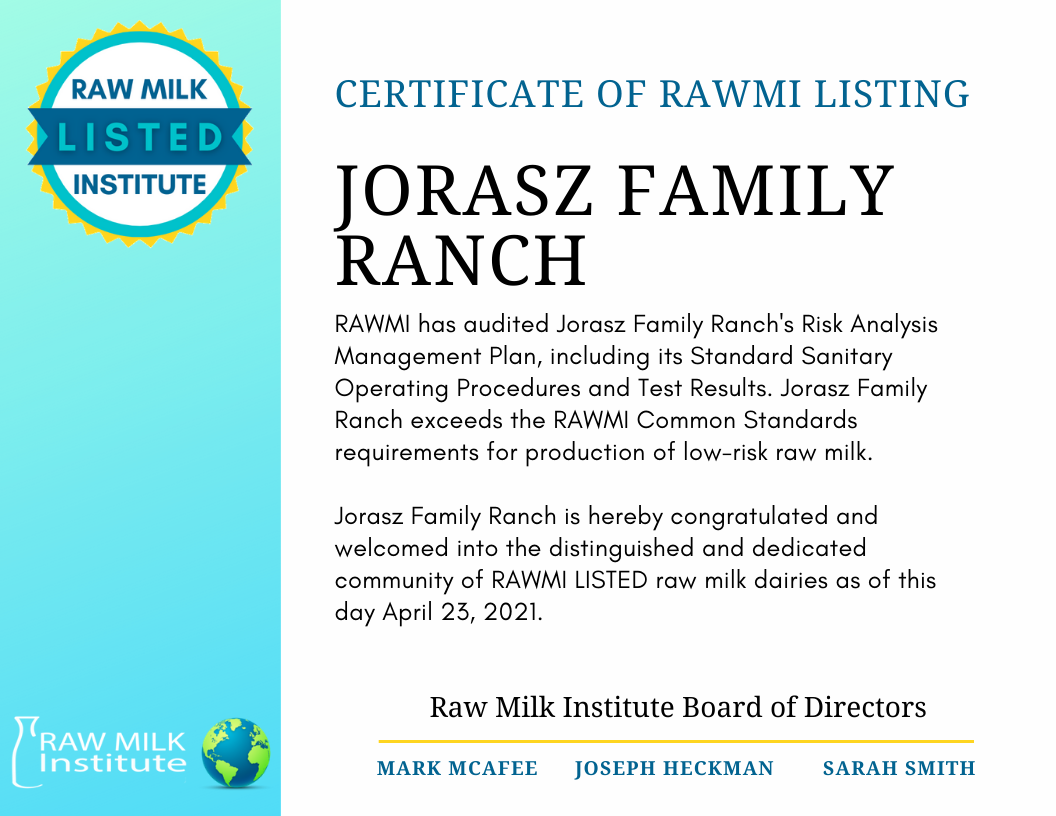

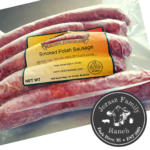
Very informative. And I love the pictures too!
❤️
Wow, so much information and so interesting. Appreciate you and all of our farmers.
Thank you!!
From the day I found you guys I felt so blessed. I’m so grateful and understand after having animals myself, not at your level for sure, but still not a city boy. Thank you for this information. Now I see why this milk is so wonderful. The A2A2 is great too.
All I can say is Thank you and it doesn’t seem like enough. Bless you and your family and bless those girls!
We are soooo blessed to have your support of our farm! Thank YOU for making our farm possible!
Teri —- Thank you, Thank you, Thank you! Excellent information and very nicely presented! Delighted to be a Herdshare Member of yours – you do it right and my comfort level is high. Very much appreciate your professionalism! Very appreciative too of your professions of Christian faith and living a Godly life!
Thank you!!!! We appreciate you!